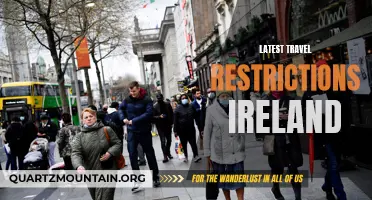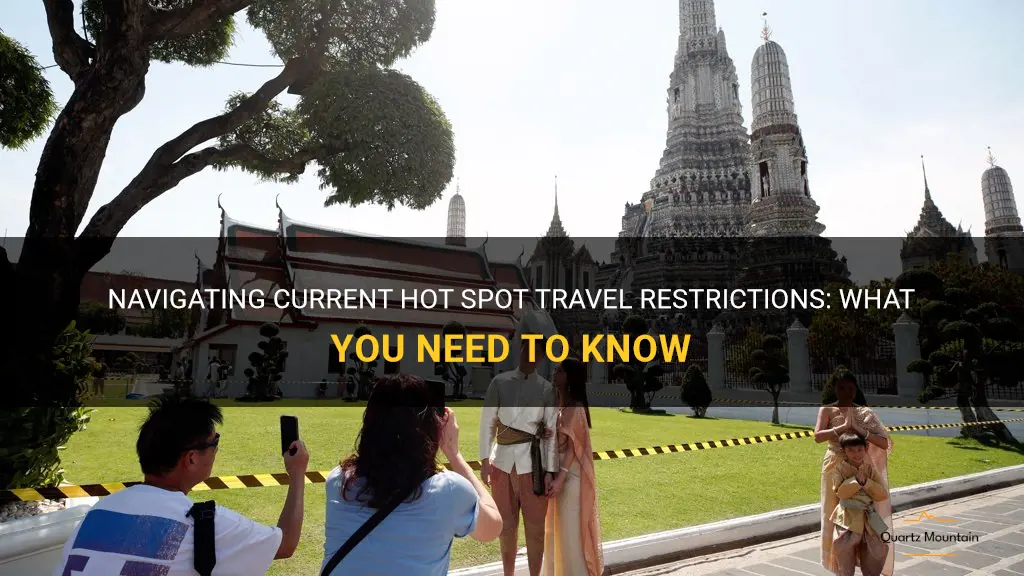
Hot spot travel restrictions have become a hot topic in the travel world. As the world grapples with the ongoing COVID-19 pandemic, many countries and regions have implemented restrictions on travel to areas with high infection rates, known as hot spots. These restrictions vary from country to country and are often fluid, changing as new information and data emerge. While these restrictions may be necessary for public health and safety, they have created a complex and challenging landscape for travelers. In this article, we will explore the current state of hot spot travel restrictions and how they are impacting the travel industry and individual travelers. So buckle up and prepare for a journey through the world of hot spot travel restrictions!
What You'll Learn
- What are hot spot travel restrictions?
- How do hot spot travel restrictions differ from regular travel restrictions?
- How are hot spot travel restrictions determined and enforced?
- What are the consequences for travelers who violate hot spot travel restrictions?
- Are there any exceptions or exemptions to hot spot travel restrictions?

What are hot spot travel restrictions?
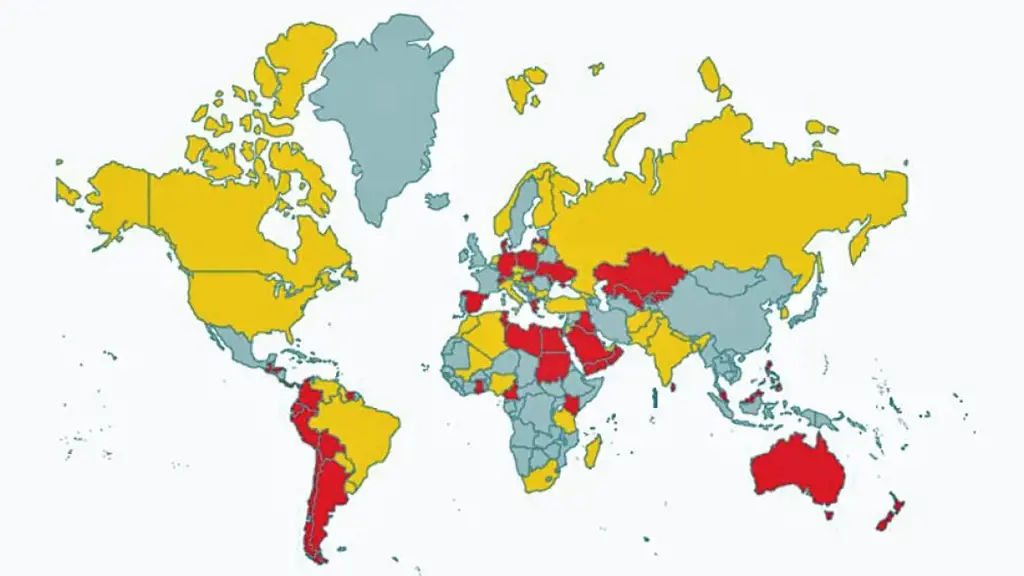
Hot spot travel restrictions refer to the rules and regulations put in place by governments and authorities to control the movement of people in areas that are experiencing a high number of COVID-19 cases. These restrictions are typically implemented to limit the spread of the virus and protect public health.
Hot spots are areas where the infection rate is significantly higher than in other regions. They can be a city, a state, or even an entire country. When a location becomes a hot spot, authorities often take immediate action to contain the spread of the virus and reduce the burden on the healthcare system.
Travel restrictions for hot spots can vary depending on the severity of the situation and the country or region in question. Common measures include:
- Border control: Many countries have implemented stricter border control measures, such as mandatory testing or quarantine for incoming travelers. Some hot spots may even close their borders entirely to non-essential travel.
- Quarantine requirements: Travelers from hot spots might be required to undergo a mandatory quarantine upon arrival, either at a designated facility or at their own accommodation. The duration of the quarantine can vary from a few days to several weeks, depending on the local regulations.
- Travel advisories: Governments often issue travel advisories alerting their citizens about the risks of traveling to hot spots. These advisories may discourage non-essential travel or recommend necessary precautions for those who still choose to travel.
- Testing requirements: Many destinations require travelers to provide a negative COVID-19 test result before entering or upon arrival. These tests are usually PCR tests and should be taken within a specific time frame before travel.
- Health screenings: Travelers may be subject to health screenings, such as temperature checks and symptom assessments, at airports or other entry points.
It is essential for travelers to stay updated on the latest travel restrictions for hot spots before embarking on any trips. This information can be obtained from official government websites, travel advisories, or local travel agencies. It is also crucial to comply with the rules and regulations set by the authorities to ensure personal safety and the well-being of others.
Additionally, it is advisable to have travel insurance that provides coverage for unexpected disruptions or cancellations due to travel restrictions. Flexible booking options are also recommended to allow for changes or cancellations if necessary.
Ultimately, hot spot travel restrictions are put in place to mitigate the spread of COVID-19 and protect public health. By adhering to these restrictions, individuals can play their part in preventing the further transmission of the virus and contribute to the overall global effort to combat the pandemic.
A Guide to the Current South America Travel Restrictions: What You Need to Know
You may want to see also

How do hot spot travel restrictions differ from regular travel restrictions?

Hot spot travel restrictions differ from regular travel restrictions in several ways. While both types of restrictions aim to control the movement of individuals to prevent the spread of diseases, hot spot travel restrictions focus on specific regions or areas that are experiencing a high number of cases. Here are some key differences between hot spot travel restrictions and regular travel restrictions:
- Targeted approach: Hot spot travel restrictions are more focused and target specific areas that have a high number of COVID-19 cases. Regular travel restrictions, on the other hand, are usually country-wide or region-wide and may not be as precise in terms of targeting high-risk areas.
- Variation in severity: Hot spot travel restrictions may be more severe and restrictive compared to regular travel restrictions. In areas with a high number of cases, travel bans or quarantine requirements may be implemented to contain the spread of the virus. Regular travel restrictions may be less severe or may focus on screening and testing measures.
- Fluidity of restrictions: Hot spot travel restrictions can change more frequently compared to regular travel restrictions. As the situation evolves and new hot spots emerge, travel restrictions may be implemented or relaxed accordingly. Regular travel restrictions may be more stable and less likely to change frequently.
- Different criteria for determining hot spots: Hot spot travel restrictions are usually based on specific criteria such as the number of cases per population, test positivity rate, or hospital capacity. Regular travel restrictions may be based on broader factors such as the overall number of cases in a country or region.
- Cooperation between jurisdictions: Hot spot travel restrictions often require cooperation between different jurisdictions. In some cases, neighboring regions or countries may work together to implement coordinated travel restrictions for hot spots. Regular travel restrictions may be imposed unilaterally by a single jurisdiction without the need for extensive coordination.
It is important to note that hot spot travel restrictions are implemented as a precautionary measure to prevent the spread of the virus. Travelers should stay updated with the latest travel advisories and follow the guidelines provided by health authorities to ensure their safety and the safety of others.
Exploring the Impact of DUI on Canada's Travel Restrictions
You may want to see also

How are hot spot travel restrictions determined and enforced?
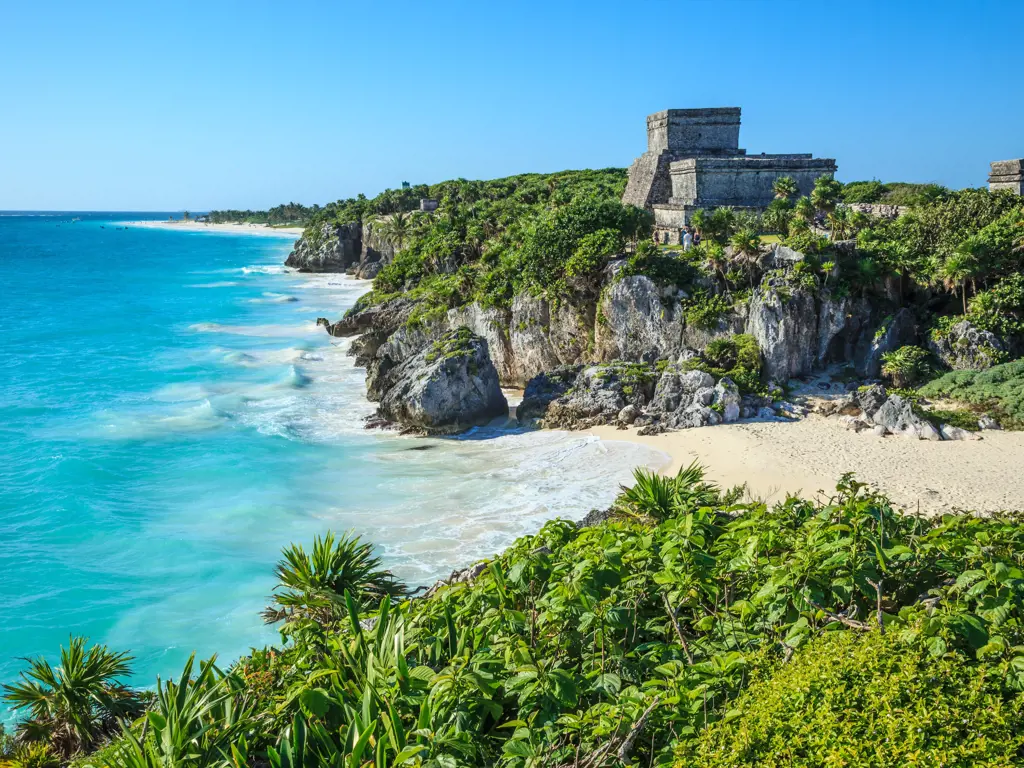
Hot spot travel restrictions are determined and enforced by governments in order to protect their citizens from the spread of diseases and to mitigate the impact of outbreaks. These restrictions can vary depending on the severity of the situation and the specific measures implemented by each country.
The determination of hot spots is based on various factors, including the number of confirmed cases, the rate of transmission, and the capacity of the local healthcare system to effectively respond to the outbreak. Governments may also take into consideration data from international health organizations, such as the World Health Organization (WHO), to assess the risk level of different regions.
Once a hot spot is identified, travel restrictions can be implemented in different forms. These may include complete border closures, travel bans from specific countries or regions, or mandatory quarantine measures for travelers coming from high-risk areas. Some governments may also introduce travel advisories or warnings, urging their citizens to avoid non-essential travel to certain destinations.
Enforcement of these travel restrictions is done through various methods. At airports and other border control points, authorities may conduct additional screenings and checks to identify and isolate individuals who may be infected. Travelers may be required to provide proof of a negative COVID-19 test result before boarding a flight or entering a country.
Additionally, governments can impose penalties for individuals who violate travel restrictions. These penalties may include fines, jail time, or deportation for foreign nationals. Some countries have also implemented technology-based solutions, such as tracking apps or electronic bracelets, to ensure compliance with quarantine measures.
Enforcement can also involve cooperation between governments. Countries may share information and coordinate efforts to track and monitor travelers who may have been exposed to the virus. This can include sharing passenger manifests, travel histories, and other data to help identify potential cases and prevent further spread.
It's important to note that hot spot travel restrictions are not intended to permanently isolate affected regions or countries. They are temporary measures taken to control the spread of disease and protect public health. As the situation improves and the number of cases decreases, these restrictions can be lifted or modified accordingly.
In conclusion, hot spot travel restrictions are determined based on the severity of the outbreak and the risk level of specific regions. Governments enforce these restrictions through measures such as border closures, travel bans, and quarantine requirements. Compliance is ensured through screenings, penalties for violations, and cooperation between countries. These restrictions are temporary and aimed at protecting public health during outbreaks.
Exploring the Impacted Travel Landscape: Canada-Egypt Travel Restrictions Amidst the Pandemic
You may want to see also

What are the consequences for travelers who violate hot spot travel restrictions?

The COVID-19 pandemic has forced governments around the world to impose travel restrictions in a bid to control the spread of the virus. These restrictions include designating certain areas as hot spots and prohibiting travel to and from these regions. Hot spots are areas where there is a high rate of COVID-19 cases, making them potential breeding grounds for further transmission of the virus.
For travelers who violate these hot spot travel restrictions, there can be serious consequences. Governments have implemented various measures to enforce these restrictions in order to protect public health and ensure the safety of their citizens. Here are some of the consequences that travelers may face if they choose to ignore these travel restrictions:
- Fines and penalties: Many countries have imposed hefty fines and penalties for violating hot spot travel restrictions. These fines can range from a few hundred dollars to several thousand dollars, depending on the severity of the violation. In some cases, repeat offenders can face even more severe penalties, including imprisonment.
- Quarantine and isolation: Travelers who violate hot spot travel restrictions may be required to undergo mandatory quarantine or isolation upon arrival at their destination. This can range from a few days to several weeks, depending on the local regulations and the risk posed by the hot spot region. Quarantine and isolation measures are put in place to ensure that individuals are not carrying the virus and spreading it further.
- Denial of entry: Some countries may refuse entry to travelers who have violated hot spot travel restrictions. This means that individuals may be turned away at the border or denied boarding on a flight. This can result in disruption to travel plans and additional expenses for rebooking flights or finding alternate routes.
- Legal consequences: In extreme cases, violating hot spot travel restrictions can have legal implications. Some countries have enacted specific laws to address violations of travel restrictions during the pandemic. This can lead to criminal charges and legal proceedings, which can carry more severe penalties than fines or quarantine measures.
It is crucial for travelers to stay informed about the latest travel restrictions and comply with them to avoid these consequences. The COVID-19 pandemic is a global crisis, and it requires everyone's cooperation to prevent the further spread of the virus. By following travel restrictions and adhering to public health guidelines, travelers can help protect themselves and others from COVID-19.
In conclusion, travelers who violate hot spot travel restrictions can face a range of consequences, including fines, quarantine or isolation, denial of entry, and legal consequences. It is important for individuals to comply with these restrictions in order to safeguard public health and prevent the spread of COVID-19. By doing so, we can all contribute to the global efforts to overcome the pandemic and return to normalcy sooner.
Criminal Record Travel Restrictions in the Dominican Republic: What You Need to Know
You may want to see also

Are there any exceptions or exemptions to hot spot travel restrictions?
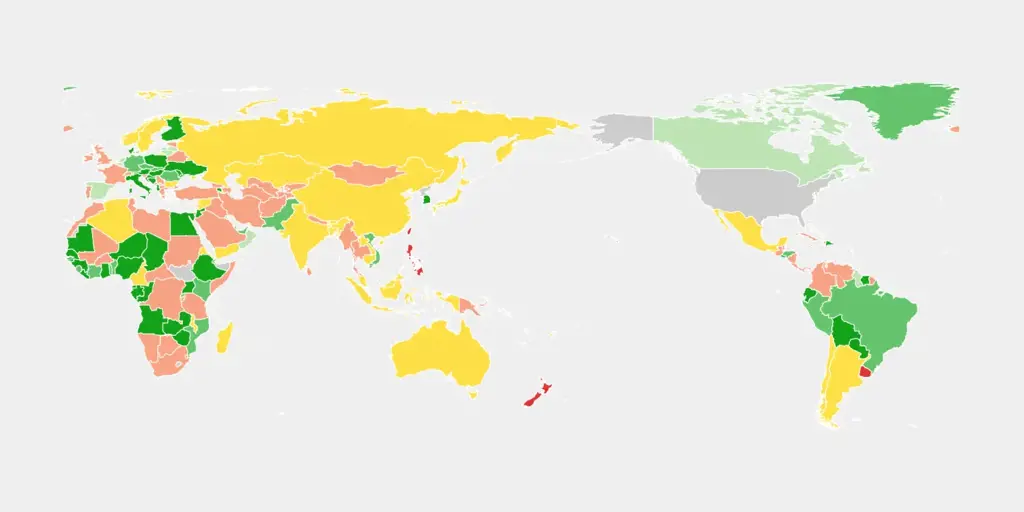
As the COVID-19 pandemic continues to impact travel, many countries have implemented travel restrictions and advisories in an effort to contain the spread of the virus. One common measure is a travel ban or restriction on individuals coming from countries or regions with a high number of COVID-19 cases, commonly referred to as "hot spots."
While these travel restrictions are generally enforced to protect public health, there may be exceptions or exemptions implemented in certain cases. It is important to note that these exceptions or exemptions can vary from country to country and are typically based on specific criteria or circumstances.
Medical emergencies can often be a valid reason for exemption from travel restrictions. If an individual requires urgent medical attention in a country with travel restrictions, they may be allowed to enter even if they are coming from a hot spot. However, it is crucial to consult with the relevant authorities and follow the necessary protocols before making any travel arrangements.
Diplomatic or government officials may also be exempt from travel restrictions. This is because officials often need to travel internationally for essential diplomatic or governmental work. However, the exemption is typically limited to individuals who hold specific positions and can provide proper documentation to prove their official capacity.
Certain essential workers or individuals involved in critical infrastructure may also be exempt from travel restrictions. For example, healthcare professionals, researchers, or individuals involved in the transportation industry may be allowed to travel across borders despite hot spot restrictions. Once again, it is essential to verify the specific requirements and guidelines set by the country of destination before making any travel plans.
In some cases, individuals who have completed a full vaccination regimen may be exempt from travel restrictions. Proof of vaccination and adherence to other health measures, such as testing or quarantine protocols, may be required. However, it is important to note that not all countries have adopted this exemption, and the type of vaccine and the date of vaccination can also be factors to consider.
It is crucial to keep in mind that even if exemptions or exceptions exist, it is still essential to adhere to all health and safety measures in place. This can include pre-departure testing, wearing masks, practicing social distancing, and following quarantine requirements if necessary.
In conclusion, while hot spot travel restrictions are generally implemented to limit the spread of COVID-19, there may be exceptions or exemptions in specific cases. Medical emergencies, diplomatic or government officials, essential workers, and fully vaccinated individuals may be exempt from these restrictions in some circumstances. However, it is important to consult with the relevant authorities and follow all necessary protocols before making any travel arrangements.
The Impact of Air Travel Restrictions on Alcohol Consumption
You may want to see also
Frequently asked questions
Yes, many countries have implemented travel restrictions for hot spot destinations to help contain the spread of COVID-19. These restrictions can include mandatory quarantine periods upon arrival, proof of negative COVID-19 test results, and limited entry for non-essential travelers.
You can stay informed about hot spot destinations by regularly checking travel advisory websites and consulting official government sources. These sources provide up-to-date information on which areas are experiencing high numbers of COVID-19 cases and are considered high-risk for travel.
While it is ultimately up to individuals to decide whether to travel, it is strongly advised to follow the guidance of health authorities and avoid non-essential travel to hot spot destinations. Traveling to these areas can put you at increased risk of exposure to COVID-19 and may also contribute to the spread of the virus.
If you travel to a hot spot destination and need to return home, you may be subject to additional travel restrictions or quarantine requirements upon your return. It is important to check the entry requirements and quarantine guidelines of your own country or region to ensure you are prepared for any necessary precautions upon your return.
The duration of travel restrictions for hot spot destinations can vary depending on the evolving situation and the effectiveness of containment measures. It is difficult to predict exactly how long travel restrictions will remain in place, but it is advisable to stay informed about the situation and follow the guidance of health authorities for the most up-to-date information.





